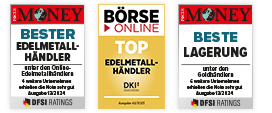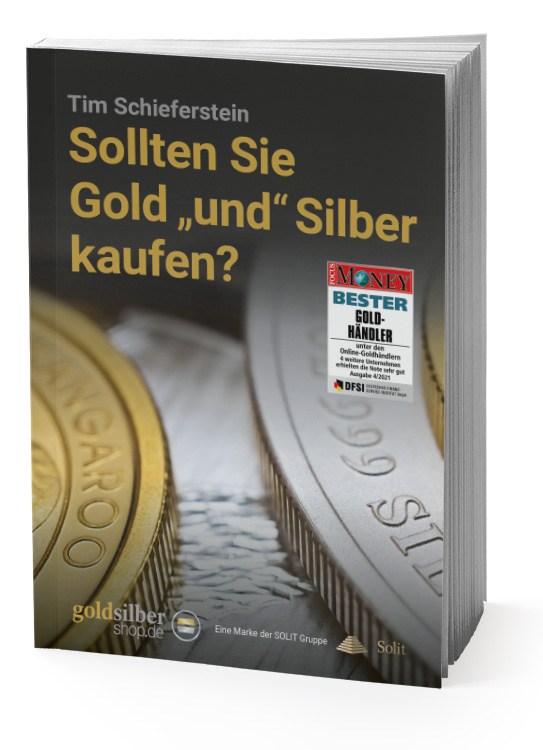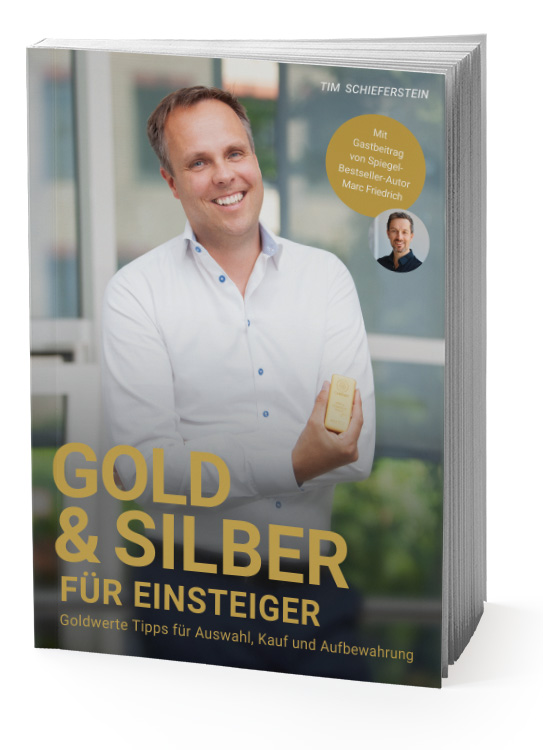Forward market transactions with gold and silver
Index certificates
Index certificates track e.g. the development of precious metal prices or the gold and silver mining indices HUI or XAU. They are sometimes currency-hedged, so that the development of precious metal prices can be tracked in different currencies. However, the certificates are associated with high, sometimes "hidden" costs. In addition, the risk of a possible default of the issuer, i.e. the bank issuing the certificate, must be borne.
Warrants
Warrants are interesting for risk-averse, short-term investors. They can be used to amplify (leverage) the upward or downward development of an underlying asset - e.g. precious metal prices or stock market prices of mining companies. The advantages of warrants are that a certain profit can be achieved with a comparatively small capital investment and that it is possible to bet not only on rising prices (call) but also on falling prices (put). Disadvantages are the limited term of the warrant and the high risk of losing the capital investment.
Futures and options
Futures and options are instruments of the futures markets that are primarily relevant for institutional investors. Commodity futures exchanges play an important role for the precious metals market, as production and demand diverge in time and space. The construction of a mine is cost-intensive and takes years, so that it is hardly possible to react to increases in demand at short notice by increasing production. In addition, mine production is distributed relatively evenly throughout the year, while demand is subject to seasonal fluctuations. The trading of futures and options serves to even out these disparities between supply and demand and to enable producers and buyers alike to hedge against the risks of price fluctuations. Since the mechanisms of futures markets are difficult to understand and the transparency of the operations of the trading of derivatives conducted here is sometimes poor, there are various conspiracy theories about what happens on these markets and how the alleged manipulative actions of market participants possibly affect the prices of precious metals. The digression explains how to think about trading on a commodity futures exchange.
Guide to buying gold and silver free as an eBook
This guidebook is not so much about what mistakes you should avoid when buying gold and silver, but what are the differences and similarities or advantages and disadvantages of the two precious metals gold and silver in comparison? What to look for when buying gold or silver? How does the gold-silver ratio behave and where can you view this and much more red-hot information? You will receive our guide free of charge as a PDF file when you sign up for our newsletter.
Futures trading on the COMEX
The most important commodity futures exchange for raw materials is the New York Commodities Exchange (COMEX), which was founded in 1933.[1] In simple terms, mining producers are the sellers and processing companies are the buyers; in addition, financial intermediaries and hedge funds are on the buyer side, while investment funds and speculators are on the seller side. The primary function of the commodity futures exchange is to enable sellers and buyers to protect themselves against price risks by entering into hedging transactions.
By far the largest share of gold and precious metals to be delivered is traded on the COMEX. At the time the transaction is concluded, it is therefore open where the precious metal will come from in the event of delivery. Since the promise to deliver refers to a future point in time and does not have to be physically backed, this involves a temporary notional increase in supply.
Every short position on a futures market is matched by a long position as an offsetting position. The short side expects falling prices and increases the de facto supply, the long side expects rising prices, which leads to rising demand at the maturity date. Whoever takes a short position is obliged to deposit an additional margin with the COMEX if precious metal prices rise. This ensures that delivery obligations can be met, e.g., even in the event of insolvency. If the long side insists on physical delivery, this must also take place. For this purpose, COMEX maintains its own inventories in order to be able to provide the physical goods immediately in case of doubt. For the majority of contracts, however, there is no physical delivery at all; rather, they are usually concluded by means of a financial agreement. The futures markets are regulated by the U.S. Commodity Futures Trading Commission (CFTC), which issues the Comittments of Traders (CoT) Report every Friday after the close of trading; the CFTC is designed to protect investors in this market segment from manipulation, abusive trading practices, and fraud.[2] The CFTC also regulates the futures market
Shortages and conspiracy theories in the futures market
Stocks of gold, and especially silver, can no longer generate a positive return.[4] Various causes are conceivable for rising lease rates: Supply-side factors would include unexpected production outages or sudden cost increases, for example, due to an increase in energy prices. More often, demand-side factors are likely to be the trigger. A sudden increase in demand, for example, due to a new industrial application or rising investor interest as a result of a loss of confidence in the currency system would be conceivable. This does not necessarily have to be associated with a change in physical demand for precious metals. If this were a prerequisite, futures markets would be useless as an early warning system. All that is needed is for market participants to expect that this could occur in order to trigger corresponding reactions from the futures markets.
The futures markets indicate the risk of a shortage at an early stage to give the markets an opportunity to adjust to it. Although the market still pays far too little attention to the medium-term scarcity of silver, a high net short position is an indication (in the sense of a contra indicator) of a short-term scarcity. According to empirical studies, there is a negative correlation - albeit a weak one - between the size of short positions and the price of silver.[5] This has prompted conspiracy theorists to suspect deliberate manipulation of the silver market due to the temporarily very high number of short contracts. The most conspicuous in this respect is also the silver analyst Ted Butler, who already attracted inglorious attention in connection with the quantification of the above-ground silver stocks (cf. Supply of Gold and Silver) and who has been preaching for years that both the silver market and the silver price were deliberately manipulated. He claims, "There is a crime happening with silver."[6] It remains mostly nebulous, however, exactly what Butler means here by manipulation.
The alleged conspiracy theorists take the position that price increases on the silver market were deliberately prevented in the 1990s by silver sales via the futures markets, which in their view would otherwise have occurred due to the high supply deficits - which were covered by disinvestments and government sales, but also by producer hedging. However, the silver price rose then yes since the year 2003 clearly and there are meanwhile again supply surpluses (see also Historical development gold price silver price). The conspiracy theory, which serious silver market analysts do not indulge in anyway for lack of any insight value, however misjudge the functioning of the precious metal and especially the futures markets.
As is well known, speculation is one of the trademarks of the stock market. It is also true that speculative aspects have a great weight on the futures markets, but at the same time they fulfill very important functions, because without the much-maligned hedge funds and speculators the precious metal markets would not function at all. Indeed, they are the ones who provide liquidity to the market and balance market imbalances between supply and demand in terms of time, space and volume.[7] Therefore, they are of considerable importance in ensuring the functioning of the gold and silver market. For example, a silver mine that wants to sell ten tons of silver today can use the futures markets to meet the jewelry retailer's silver demand of two tons in three months and the electronics company's demand of eight tons in six months. There is no longer a direct relationship between the producer and the buyer. In this respect, the futures market can be regarded as a black box. However, the legendary Hunt speculation in the 1970s showed that spectacular excesses can occur on the futures markets (see Historical Development of Gold Price Silver Price). At the time, a collapse of the financial sector could only be prevented - as was also the case during the financial market crisis of 2008/2009 - by massive intervention by the central banks.

Weitere Informationen und Ihre nächsten Schritte:
Geschichte von Edelmetallen als Währung
Angebot, Nachfrage und Bestände
Historische Wertentwicklung
Prognose für die zukünftige Wertentwicklung
Investitionsmöglichkeiten
Zusammenfassung
Silber Neuheiten
Feinsilber
Silber kaufen
1 kg Silbermünzen
1 Unze Silbermünzen
Silberunze
Tubesize
Silberankauf
Ankauf von Silberbarren
Ankauf von Silbermünzen
Maße & Gewicht: Silberbarren
Mehrwertsteuer bei Silber
Silberpreis
Das deutsche Stempelgesetz von 1884
Edelmetalle
Edelmetalle kaufen
Edelmetalle verkaufen
Gold, Silber lagern
Gold-Silber-Ratio
Privy Mark Münzen
Goldsparplan oder Silbersparplan
Goldverbot
Echtheit von Gold prüfen
Hausratversicherung für Gold
Tresor
Bankschließfach
Buch & eBook “Gold & Silber für Einsteiger” gratis für Sie
„Ein spannendes und lehrreiches Buch, das selbst für Leute wie mich, die sich noch nie mit dieser Thematik auseinandergesetzt haben, das Interesse an einer Investition in Edelmetalle weckt.“ – Fazit der Lektorin, die anschließend erstmalig Gold kaufte.
Was sind die Vor- und Nachteile von Edelmetallen? Welche Barren und Münzen sind warum empfehlenswert? Was sind typische Anfängerfehler und woran erkennt man einen seriösen Edelmetallhändler? Wo und wie bewahrt man Edelmetalle sicher auf? Auf diese und viele weitere Fragen finden (nicht nur) Einsteiger in dieser rund 200 Seiten umfassende Basislektüre von Edelmetall-Experte Tim Schieferstein zum Thema Gold und Silber Antworten und Tipps.
Mit diesem Buch möchten wir Aufklärungsarbeit leisten und so den Einstieg in eine Kapitalanlage in Edelmetallen leicht machen. Daher schenkt GoldSilberShop.de sowohl das eBook als auch das gedruckte Buch Ihnen! Sichern Sie sich noch heute Ihr Exemplar!
[2] Vgl. Mildner, S. und D. Knohte (2009), Abschied vom Benign Neglect? Auf dem Weg zu einer neuen Finanzmarktordnung in den USA (Internet: swp-berlin.org/fileadmin/contents/ products/2009_S20_mdn_knothe_ks.pdf, Abruf vom 01.10.2012): S. 31.
[3] Zum Thema Silber-Leihraten ein Kuriosum am Rande: Nachdem bekannt wurde, dass durch den Einsturz des World Trade Centers am 11. September 2001 eintausend Tonnen Silber verschüttet wurden, verdreifachten sich die Leihraten. Die Situation entspannte sich, als das Silber aus den unterirdischen Tresoren wieder geborgen wurde.
[4] Vgl. Weinberg, E. (2005), Silber: goldene Zeiten (Internet-Abruf vom 01.10.2012).
[5] Dieser der Tendenz nach bestehende Zusammenhang konnte beispielsweise für den Zeitraum 1986 bis 2003 gezeigt werden; vgl. Nussbaumer, M. (2004), Der „Wert“ von Silber? (Internet-Abruf vom 01.10.2012).
[6] Vgl. Butler, T. (2009), Eine Lüge nach der anderen (Internet: goldseiten.de/content/diverses /artikel.php?storyid=12426, Abruf vom 01.10.2012).
[7] Vgl. Eibl, C. (2008), Alles, was Sie über Gold wissen müssen – Hintergründe, Fakten und Anlagetipps für den wichtigsten Rohstoff der Zukunft. 2. Auflage. Finanzbuch Verlag, München: S. 184.








